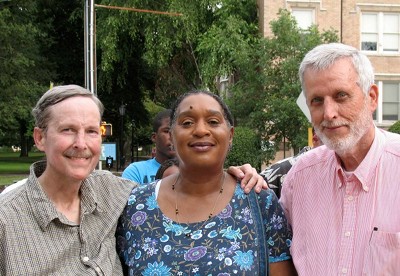According to today’s Chapel Hill News (IFC may delay new shelter), the Inter-Faith Council is looking at a delay while the questions raised by local residents over the last few weeks are resolved.
Inter-Faith Council director Chris Moran said the agency may delay its development permit application amid neighbors’ opposition to a new men’s homeless shelter on Martin Luther King Jr. Boulevard at Homestead Road.
Despite support from United Church of Chapel Hill, which is adjacent to the site, Moran faced a throng of red-clad protesters as the Town Council reviewed IFC’s concept plan for a 50-bed shelter last week. These neighbors anticipated homeless men loitering, panhandling or causing other mischief around their homes, schools and Homestead Park — basically, the same complaint some downtown merchants and visitors have expressed about the street people downtown.
The council challenged IFC to address these concerns and explain how the agency chose the Homestead site. For example, IFC is seeking detailed crime data from the police department for its Rosemary Street shelter.
That sort of research could disrupt IFC’s initial plan to gain a permit about a year from now and open the doors in January 2012.
“We will probably delay the special-use-permit process,” said Moran. “It would be disrespectful for us to file for an SUP permit if these questions haven’t been answered.”
I asked Police Chief Curran a couple weeks ago for some of the required statistics (here).
I’ve read every email forwarded to the candidates on this issue with an eye towards publishing those questions for inspection by the wider community.
Luckily, Tina Coyne-Smith, one of the concerned citizens that has taken a lead on this issue, prepared a detailed assessment of the neighborhoods’ issues for her presentation to Council last week.
She has also graciously provided a copy (here [PDF]) so that the public, the IFC and other stakeholders can review and respond in a fact-based manner.
The three categories of concerns driving opposition are:
- Proximity of the shelter to a park, residential neighborhoods, and daycares, afterschool programs, and schools
- Unintended consequences of the shelter that raise safety concerns
- Inequitable distribution of human services in NW Chapel Hill incurred by placing the shelter at the proposed site
A few of the underlying issues raised have been answered by Chris Moran in the FAQ he provided earlier here (Q&A IFC Community House).
I also recently asked the Town’s Attorney Ralph Karpinos if the IFC, in cooperation with the police, could rule out who on the list of incidents was not a shelter resident. Anecdotal evidence indicates that folks report their address as the shelter even when they aren’t clients. He responded that this was a question for the IFC.
While I believe there is value in sharpening up the statistics, I also want to protect the privacy of those that IFC serves. Any method the Town uses to get a better grasp of the scope of this potential problem must honor folks right to privacy.
Whatever the outcome of the current discussion, the process used must be transparent, fact-based and use a decision-making framework that incorporates the requirements of the IFC, community-based criteria (as with the waste transfer site selection), the Town’s legal and developmental guidelines along with a strong dose of common sense.
Given the respectful tone established by Tina, Chris and many of the other folks that spoke last Monday, I believe that our community can not only reach a consensus on this particular issue without bitterness but also take this opportunity to work even harder on addressing the problems driving and accompanying homelessness in our local community.

